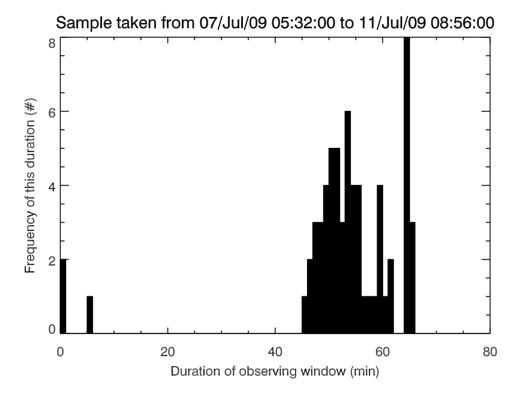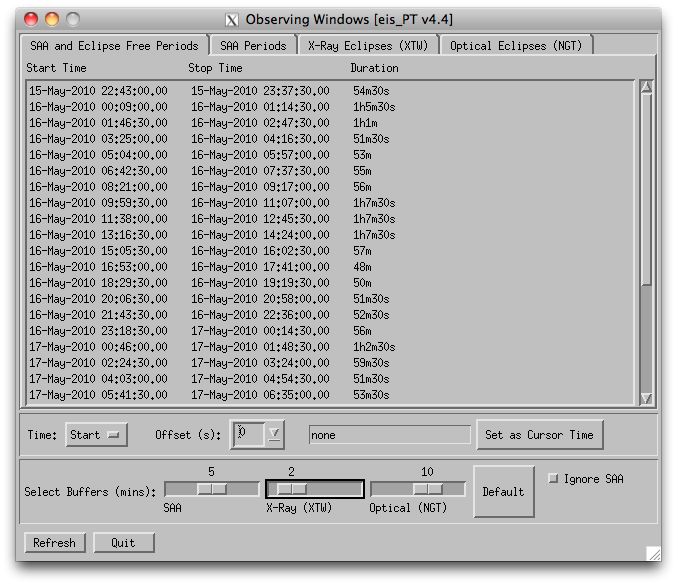Observing with EIS with the new antenna#
Table of Contents
- Observing with EIS with the new antenna
- About this page
- Practical constraints
- Time
- OP Periods
- Post-pointing delay
- Eclipse Season (XTW)
- South Atlantic Anomaly (SAA)
- Overlap of SAA and Eclipse
- XRT Synoptic Re-pointings
- Buffer summary
- Volume
- Typical volume allocation
- Do you have examples of what kind of observations are best suited for EIS?
- Hinode Operation Plans (HOPs)
- ISAS site guidance
- Why can my old HOP no longer be run?
- How is the HOP process different?
- Extras
- Nomenclature
About this page#
This Wiki page deals with typical observing constraints that you need to bear in mind when making a proposal for observing with Hinode EIS.Practical constraints#
Time#
OP Periods#
An OP Period[1] is the period of time during which an observing programme (plan) is defined. e.g. from 10:23 UT on 2008/05/02 to 11:19 UT on 2008/05/04. (The start and end of each OP period are determined by the pattern of ground-station contacts, which varies from day to day.)Since the transition to stable operations under the S-band antenna, typical OP Period durations have been two or three days.
Once solar activity begins to increase, and solar unpredictability increases accordingly, Hinode may consider more frequent (i.e., one-day-long) OP Periods.
Post-pointing delay#
In order to have co-ordinated observations by its three instruments, Hinode points as a whole satellite (using its AOCS[6]), either tracking a point to compensate for the (differential) rotation of the Sun, or focusing on a fixed point. Either way, changes in pointing by the s/c[7] take time to stabilise. After approximately 90 seconds, Hinode can track or fix on a point with better than 1" accuracy, below the spatial resolution of EIS and XRT.To avoid observing during the stabilisation of pointing, EIS observations normally start at least two minutes after a satellite re-point.
To see what an Hinode re-pointing schedule looks like, take a look at an example on the Hinode Daily Operations website here
Eclipse Season (XTW)#
Hinode is an Earth-orbiting, sun-facing satellite, and its orbit is Sun-synchronous. However, like other satellites in similar orbits (e.g., TRACE, RHESSI), during eclipse season[5], the line of sight between the spacecraft and the Sun grazes the Earth's atmosphere, causing attenuation (and ultimately complete absorption) of the light that would otherwise be seen by each of the instruments. This attenuation affects first the EUV and X-ray bands, then later the visible wavelength range.As of 2009, JAXA ephemeris calculations for Hinode included the calculation of nominal EUV and X-ray night (known as XTW). The duration of these is approximately 30 minutes at the peak of eclipse season (2009). This is calculated from a static model, and so doesn't take into account expansion of the ionosphere with increased solar activity, which would lengthen these obscuration periods.
For some more information, see the notes on EclipseEffects.
South Atlantic Anomaly (SAA)#
On most orbits[8], Hinode's orbit intercepts the South Atlantic Anomaly (SAA), a part of the geomagnetic environment where high-energy particles penetrate lower into the magnetosphere. During such passes, significantly more energetic particle hits (cosmic rays) are observed on the EIS detector images. These passes are calculated at the same time as other orbital events (such as Eclipse Season NGT events, when appropriate), and times vary each day. Such passes normally last approximately 15 to 20 minutes (although they can be calculated to last for as little as 30 seconds).Additionally, because the SAA rotates with the Earth — whereas the orbit of Hinode does not — the phase of Hinode's orbit at which each SAA event occurs varies.
However, around 12 UT, Hinode experiences a so-called Golden Period where the SAA itself does not intercept the s/c orbit. Because the SAA passes vary in time, the start of this period can range (approximately) from 10 to 11 UT, with the end being anywhere from 14 to 16 UT.
The EIS team use a rule of thumb that a 5-minute buffer around SAA events is sufficient to account for the variability in size of the anomaly itself.
N.B. the old restriction of not changing slit/slot choice during an SAA pass is no longer relevant, following an on-board software update in August 2007
Overlap of SAA and Eclipse#
There is often a substantial overlap between SAA and XTW (X-ray / EUV night) events around the orbit. However, the phase of EUV night does not change phase in the orbit in the way that that of the SAA does. Therefore nights and SAA passes sometimes coincide (with night being the longer event), and sometimes do not overlap so much. However, there is almost always some overlap. The exception to this is during the Golden Period, during which there are no SAA events, but EUV nights continue to occur once per orbit.As a result, at many times of day, the less-than-complete overlap of SAA and night means that the clear window for observing in such orbits can be shorter. From 2009, EUV Night event were calculated for Hinode's orbit. So taking into account the buffers (summarised below) around orbital events, we can recalculate the distribution of clear observing windows from the middle of eclipse season in 2009.
The histograms below show a distribution of these windows' length over a three-day sample. There are two distinct populations (ignore the very short windows at the far left: these are due to vanishingly small SAA events that occur shortly after larger events).
The main population follows a distribution ranging from 44 to 62 minutes, with a mode and median of around 53 minutes in length. The second population is on the far right, and corresponds to observing windows in the Golden Period where there are no SAAs, and these windows are 65 minutes long.
The sum of all this means that if you want to be of a single raster or study fitting in between eclipses, it needs to be no more than 44 minutes long (the minimum window length). However, if you are happy accepting some curtailment of the raster at one or both ends outside the Golden Period, in order to make full use of those windows that fall inside the Golden Period, then you might design a study to have maximum 65 minutes' duration. It is a gamble, obviously, because they aren't so well suited to the majority of the observing day, and cause difficulties in forecasting the telemetry that will be accumulated because images will be taken when EIS can't see the Sun.
 |
XRT Synoptic Re-pointings#
One caveat to the above information on observing windows is that (currently) twice a day, Hinode's X-Ray Telescope (XRT) makes a so-called synoptic observation of the Sun. This requires the satellite to point at solar disc centre. However, because XRT is sensitive to particle radiation, and X-ray nights are almost equivalent to EUV nights, it requires these observations to be taken during one of the clear observing windows (above). The duration of XRT's programme (including the time taken to re-point) is 10 minutes. Factoring in the 2 minutes post-pointing delay after the synoptic, this means that observing windows (typically, those closest to or including 06:00 and 18:00 UT) are curtailed by 12 minutes.Buffer summary#
The table below summarises the time buffers recommended to separate observations from the corresponding events.
| Event | Buffer |
|---|---|
| Re-point | 2 minutes after |
| SAA_ENTRY | 5 minutes before |
| SAA_EXIT | 5 minutes after |
| XTW_ENTRY | 2 minutes before |
| XTW_EXIT | 2 minutes after |
Please note that as of late 2008, the planning tool has a "SHOW OBEV WINDOWS" feature that factors in these buffers. This feature is shown in the screenshot below
 |
Volume#
Typical volume allocation#
Since moving to Hinode's S-band antenna for downlinks, EIS typically can downlink something like 600 Mb[2] per 24 hours. This is worked out by the total contact time at all ground-stations, in the coming OP Period, multiplied by the bandwidth to the ground[4]. Typical HOPs should be targeted to something like 250 Mb per day. However , this is a rough guideline only, because the amount of telemetry that it's possible to downlink per day downlinked is quite variable, due to a number of practical factors.For the most recent daily allocations, you should visit the Hinode Daily Events webpages, where operations are documented, and check the typical allocation for EIS over the last few weeks. (Remember to halve this number to get a rough idea of the volume you should limit yourself to).
webpages, where operations are documented, and check the typical allocation for EIS over the last few weeks. (Remember to halve this number to get a rough idea of the volume you should limit yourself to).
Do you have examples of what kind of observations are best suited for EIS?#
Yes :-)Go over to the Study4LowDataVolume page on this Wiki for examples of programmes recently developed for EIS.
Hinode Operation Plans (HOPs)#
This is the typical banner under which joint observations with Hinode are planned. HOPs are recommended by the Science Schedule Co-ordinators for these types of observations .
.
ISAS site guidance#
We warmly encourage you to use Hinode in achieving your scientific objectives.
The ISAS Hinode Operations website has a link to a new section on Guidance for Hinode Observations
has a link to a new section on Guidance for Hinode Observations , which is worth reading through in preparation for making a proposal.
, which is worth reading through in preparation for making a proposal.
Why can my old HOP no longer be run?#
For background on the switch from X-band to S-band telemetering of data by Hinode, take a look at the Hinode Science Schedule Co-ordinators' announcement , first released in SolarNews.
, first released in SolarNews.
How is the HOP process different?#
In short, the answer to this is: not very much :-)Eighteen months of post-commisioning experience has given the Hinode team time to work out the kind of information and lead time that proposers and team personnel need in order to run observations successfully. So now, this information has been made available as ''Guidance for proposal observations (HOP)'' on the ISAS Hinode website.
on the ISAS Hinode website.
Extras#
Nomenclature#
- OP
- [1]Operation Programme
- S-band antenna
- [4] Hinode's secondary antenna, with a bandwidth of 262 kb/s.
- Eclipse Season
- [5] The portion of the year where the sun is occluded by the Earth's atmosphere for a fraction of each orbit. It lasts from late April until early September.
- AOCS
- [6] Attitude and Orbit Control System
- s/c
- [7] abbreviation of spacecraft
Other Notes
[2]: Remember, Mb stands for megabits (1024 × 1024 bits), as distinct from MB (for megabytes). 1 MB = 8Mb.
[3]: Is this correct? I know it's approximately true, since we start in late April, and come out of eclipse season in early September.
[]: Hinode's orbital period is 98.5 minutes